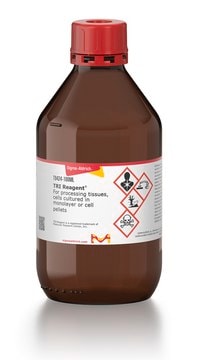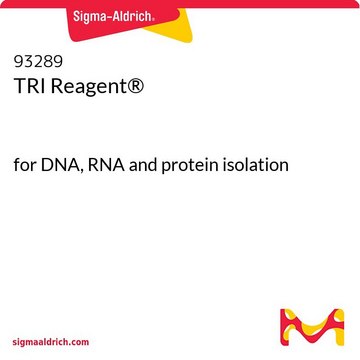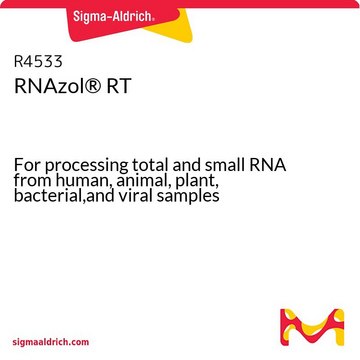Wichtige Dokumente
B9673
1-Brom-3-chlorpropan
for isolation of RNA
Synonym(e):
I-BCP, Trimethylenbromchlorid, Trimethylenchlorbromid
About This Item
Empfohlene Produkte
Qualität
Molecular Biology
for molecular biology
Assay
≥98.5% (GC)
Form
liquid
Brechungsindex
n20/D 1.486 (lit.)
bp
144-145 °C (lit.)
Dichte
1.592 g/mL at 25 °C (lit.)
Lagertemp.
room temp
SMILES String
ClCCCBr
InChI
1S/C3H6BrCl/c4-2-1-3-5/h1-3H2
InChIKey
MFESCIUQSIBMSM-UHFFFAOYSA-N
Suchen Sie nach ähnlichen Produkten? Aufrufen Leitfaden zum Produktvergleich
Allgemeine Beschreibung
Anwendung
- feline teeth
- mice brain and liver tissues
- human ectocervical epithelial cells
- placental samples
- human mesenchymal stromal cells (hMSCs)
Leistungsmerkmale und Vorteile
- less toxic alternative to chloroform
- compatible with TRI reagent for isolation of RNA with decreased DNA contamination
Sonstige Hinweise
Ähnliches Produkt
Signalwort
Danger
H-Sätze
Gefahreneinstufungen
Acute Tox. 3 Inhalation - Acute Tox. 4 Oral - Aquatic Chronic 3 - Muta. 2 - STOT SE 3
Zielorgane
Respiratory system
Lagerklassenschlüssel
6.1C - Combustible acute toxic Cat.3 / toxic compounds or compounds which causing chronic effects
WGK
WGK 2
Persönliche Schutzausrüstung
Eyeshields, Faceshields, Gloves, type ABEK (EN14387) respirator filter
Hier finden Sie alle aktuellen Versionen:
Besitzen Sie dieses Produkt bereits?
In der Dokumentenbibliothek finden Sie die Dokumentation zu den Produkten, die Sie kürzlich erworben haben.
Kunden haben sich ebenfalls angesehen
Protokolle
TRI Reagent ist ein einstufiges RNA-Isolierungsreagens, das die gleichzeitige Isolierung von DNA, RNA und Protein ermöglicht. In diesem Protokoll werden die Probenvorbereitung sowie die Extraktion verschiedener Proben und die Fehlerbehebung beschrieben.
Verfahren für Aufreinigung, reverse Transkription und quantitative PCR für MicroRNA mit MystiCq-Reagenzien
Unser Team von Wissenschaftlern verfügt über Erfahrung in allen Forschungsbereichen einschließlich Life Science, Materialwissenschaften, chemischer Synthese, Chromatographie, Analytik und vielen mehr..
Setzen Sie sich mit dem technischen Dienst in Verbindung.












